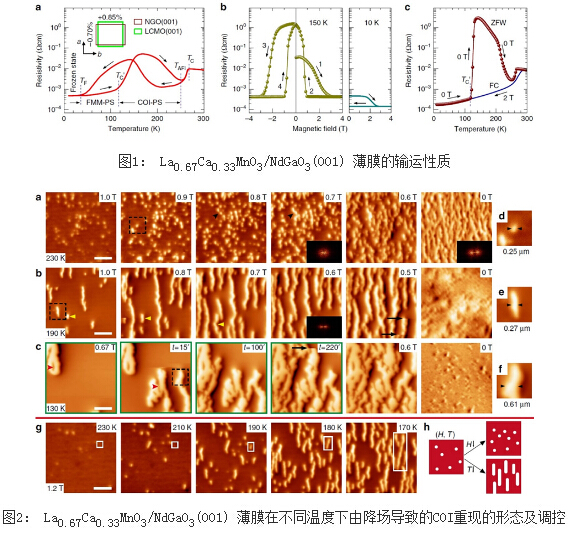
University of Hefei Institute of Physical Sciences, Chinese Academy of Sciences and China National University of Science and Technology's Microscale National Laboratory's Micro-Uranium Research Group and Wu Wenbin's research group have worked closely together for more than one year, using magnetic forces in a homemade 20T superconducting magnet. Microscopy observed the phase separation process of manganese oxides in a class of phase-separated manganese oxide films controlled by anisotropic epitaxial stress and found a rich phase separation behavior. The work was published in Nature Communications on the title Evolution and Control of the Phase Competition Morphology in a Manganite Film.
Due to the coupling of different interactions in PMR, the thermodynamic phases that are in competition can exist simultaneously. The exploration of the distribution and evolution law of these phases in real space helps to understand the role of these interactions in phase separation. Therefore, the observation of phase separation in real space has always been one of the hot spots in this field. However, since a relatively strong magnetic field is required to drive the mutual transformation of these phases, and such instruments have been relatively few, the complete process of phase separation of the manganese oxide from the charge-ordered state to reproduction has not been observed.
The La0.67Ca0.33MnO3 bulk material is the best doped ferromagnetic metal, but it was found that the La0.67Ca0.33MnO3 thin film deposited on the NdGaO3(001) substrate undergoes an annealing process due to anisotropy from the substrate. The role of epitaxial stress can induce special phase competition behavior. Below the ferromagnetic transition, new ferromagnetic-antiferromagnetic transitions (TAFI) and lower temperature antiferromagnetic-ferromagnetic transitions also occur. From the transport point of view, the resistance change curve with temperature below TAFI shows a large hysteresis, indicating that the samples are in phase separation in the temperature range below TAFI. In the phase diagram, this phase separation can be further subdivided into a phase-separated region (COI-PS) dominated by a charge-sequential insulating phase (COI) and a phase-separated region dominated by a ferromagnetic metal phase (FMM) (FMM-PS). ), the resistance-magnetic field (rH) curves of the two phase separation regions are quite different (Figure 1b). During the ascending process, as the COI gradually transforms into a ferromagnetic metal phase, the resistance drops at both temperatures, but after the ferromagnetic metal phase saturates, the COI reappears at 150K (arrows in Figure 1b 2), but not at 10K.
This reappearance of COI in the downfield process has been observed in other COI-based manganese oxides (such as Pr1-xCaxMnO3, Nd1/2Sr1/2MnO3, and LaPrCaMnO3), but previous microscopic imaging studies have either no magnetic field , or focus on the rising part of the field, so the micro details of the COI recurrence before the fall is completely unclear. This process is of great significance and can provide more information about the mutual transformation of ferromagnetic metal phases and COI.
The researchers used a self-made magnetic force microscope to perform systematic imaging of the phase separation behavior of the sample, especially the reproduction of COI during field drop. The results show that this reappearance at the microscopic level is completely different from the melting of COI at the time of ascension, and its morphology is more diverse (Figure 2).
The COI domains were spot-like at 230K, strips at 190K, and irregular flakes at 130K, while the size of COI domains gradually increased with decreasing temperature; correspondingly, the COI phase The melting field also increases with decreasing temperature, which indicates that the COI phase gradually increases. Therefore, the author proposes a physical image: at higher temperatures (230K), the COI is weaker, and the COI domain is smaller when reproduced, so it is spot-like; at the intermediate temperature (190K), the COI phase becomes stronger, The size also becomes larger. At this time, the anisotropic epitaxial stress makes the COI domain grow along a certain lattice direction. At this time, the shape of the domain reflects the characteristics of epitaxial stress; at low temperature (130K), due to COI As the phase becomes stronger, its dominant interaction (Jahn-Teller distortion) gains an advantage in competing with the epitaxial stress. Therefore, the shape of the domain now reflects the Jahn-Teller distortion characteristic (irregularity). Therefore, the importance of this work lies in inferring the competitive relationship from the phase of phase transition and competition, and at the same time, it can realize the artificial regulation of the competing forms.
The first author of the work was Dr. Zhou Haijun, Ph.D. candidate, Lu Kui Uranium and Wu Wenbin as correspondents. This work was funded by the National Natural Science Foundation of China's Natural Science Foundation and the "973" Program of the Ministry of Science and Technology.
Torx Key Set,Torx Hex Key,Torx Hex Key Set,Torx Allen Key Set
henan horn tools co.,ltd. , https://www.hornhandtools.com
